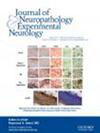患有或未患有中重度脑外伤的社区老年人的慢性外伤性脑病和与衰老相关的 Tau 星形胶质细胞病变
IF 3
3区 医学
Q2 CLINICAL NEUROLOGY
引用次数: 0
摘要
本研究调查了社区老年人中慢性创伤性脑病-神经病理改变(CTE-NC)和衰老相关的tau星形胶质细胞病变(ARTAG)的发生频率,并检验了这些tau病变与中重度创伤性脑损伤(msTBI)病史相关的假设,中重度创伤性脑损伤定义为意识丧失>30分钟的创伤性脑损伤。我们对来自拉什社区队列的94名msTBI参与者和94名无TBI参与者的CTE-NC、ARTAG和阿尔茨海默病病理变化进行了评估,这94名参与者的年龄、性别、教育程度和痴呆状态均与TBI相匹配。6人(3%)的大脑显示出CTE-NC的病理病变;其中只有3人有msTBI病史。相比之下,ARTAG 在老年大脑中很常见(灰质 ARTAG = 77%;白质 ARTAG = 54%;皮下 ARTAG = 51%);ARTAG 病变的严重程度、类型或分布与 msTBI 史没有差异。此外,msTBI患者的PHF-tau缠结密度水平不高,但淀粉样蛋白-β负荷水平较高(估计值=0.339,SE=0.164,P=0.040)。这些研究结果表明,CTE-NC 在社区中并不常见,而 ARTAG 则很常见,这两种病变都与 msTBI 无关。msTBI与淀粉样蛋白-β而非牛磺酸病的关联表明,msTBI的神经变性机制不同。本文章由计算机程序翻译,如有差异,请以英文原文为准。
Chronic traumatic encephalopathy and aging-related tau astrogliopathy in community-dwelling older persons with and without moderate-to-severe traumatic brain injury
This study examined the frequency of chronic traumatic encephalopathy-neuropathologic change (CTE-NC) and aging-related tau astrogliopathy (ARTAG) in community-dwelling older adults and tested the hypothesis that these tau pathologies are associated with a history of moderate-to-severe traumatic brain injury (msTBI), defined as a TBI with loss of consciousness >30 minutes. We evaluated CTE-NC, ARTAG, and Alzheimer disease pathologies in 94 participants with msTBI and 94 participants without TBI matched by age, sex, education, and dementia status TBI from the Rush community-based cohorts. Six (3%) of brains showed the pathognomonic lesion of CTE-NC; only 3 of these had a history of msTBI. In contrast, ARTAG was common in older brains (gray matter ARTAG = 77%; white matter ARTAG = 54%; subpial ARTAG = 51%); there were no differences in severity, type, or distribution of ARTAG pathology with respect to history of msTBI. Furthermore, those with msTBI did not have higher levels of PHF-tau tangles density but had higher levels of amyloid-β load (Estimate = 0.339, SE = 0.164, p = 0.040). These findings suggest that CTE-NC is infrequent while ARTAG is common in the community and that both pathologies are unrelated to msTBI. The association of msTBI with amyloid-β, rather than with tauopathies suggests differential mechanisms of neurodegeneration in msTBI.
求助全文
通过发布文献求助,成功后即可免费获取论文全文。
去求助
来源期刊
CiteScore
5.40
自引率
6.20%
发文量
118
审稿时长
6-12 weeks
期刊介绍:
Journal of Neuropathology & Experimental Neurology is the official journal of the American Association of Neuropathologists, Inc. (AANP). The journal publishes peer-reviewed studies on neuropathology and experimental neuroscience, book reviews, letters, and Association news, covering a broad spectrum of fields in basic neuroscience with an emphasis on human neurological diseases. It is written by and for neuropathologists, neurologists, neurosurgeons, pathologists, psychiatrists, and basic neuroscientists from around the world. Publication has been continuous since 1942.

 求助内容:
求助内容: 应助结果提醒方式:
应助结果提醒方式:


